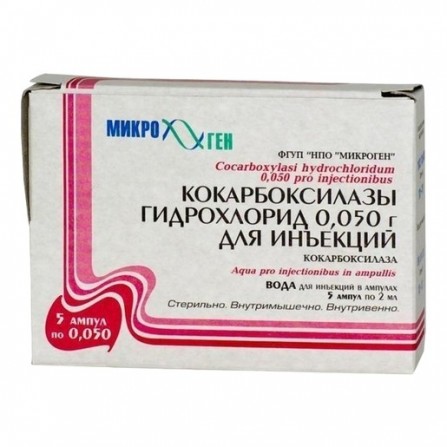Cocarboxylase powder lyophilisate for injection 50mg vial N5 with p-lem
Condition: New product
985 Items
Rating:
Be the first to write a review!

More info
Active ingredients
Cocarboxylase
Release form
Solution
Composition
Cocarboxylase hydrochloride 50 mg, Solvent: water d / and - 2 ml.
Pharmacological effect
Pharmacokinetics
Indications
Coenzyme formed in the body from thiamine. It has a metabolic effect, activates tissue metabolism. In the body it is phosphorylated to form mono-, di- and triphosphoric esters, cocarboxylase is part of the enzymes catalyzing the carboxylation and decarboxylation of keto acids, pyruvic acid, promotes the formation of acetyl-coenzyme A, which determines its participation in carbohydrate metabolism. Participation in the pentose cycle indirectly contributes to the synthesis of nucleic acids, proteins and lipids. It improves the absorption of glucose, the trophism of the nervous tissue, and contributes to the normalization of the functions of the cardiovascular system. A deficiency of cocarboxylase causes an increase in the level of pyruvic and lactic acids in the blood, which leads to acidosis and acidotic coma.
Contraindications
Adults injected in / m or / in. The dose is 50-200 mg / day. In diabetes mellitus (acidosis, coma), the daily dose may be 0.1-1 g. The frequency and duration of use depends on the evidence. Children - in / m, in / in (drip or jet), the newborn - sublingually. Children up to 3 months - 25 mg / day, from 4 months to 7 years - 25-50 mg / day, from 8 to 18 years - 50-100 mg / day. The duration of treatment is from 3-7 to 15 days.
Dosage and administration
In combination therapy: metabolic acidosis, acidosis in hyperglycemic coma, acidosis in respiratory and pulmonary heart disease, chronic heart failure, ischemic heart disease, unstable angina, myocardial infarction, postinfarction cardiosclerosis, hepatic and / or renal insufficiency, acute and chronic alhizogyrm, or an ally, will be at least one person who has developed anemia, acute myocardial infarction, myocardial infarction. cardiac glycosides and barbiturates, infectious diseases (diphtheria, scarlet fever, typhoid fever, paratyphoid fever), neuralgia, multiple sclerosis, peripheral neuritis. Tey in the neonatal period: perinatal hypoxic encephalopathy, respiratory failure, pneumonia, sepsis, hypoxia, acidosis.


